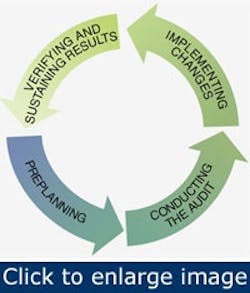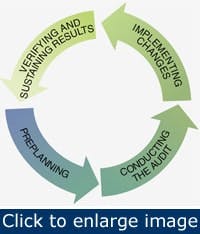Energy audit process
An energy audit is a four-step process that includes the phases of planning, investigating, implementing, and sustaining. Thorough planning and careful action increase the chances of a successful energy audit with a maximum return on investment.
Figure 1. The audit process consists of four phases. The audit process is repeated at intervals to continually improve energy efficiency.
Audit Process
An energy audit includes more than just taking measurements. In order for the measurements to be useful, they must be part of a systematic procedure to identify and implement the most cost-effective energy-conservation programs. Energy audits involve gathering system information, measuring energy use, developing conservation strategies, choosing the most cost-effective plan, implementing changes, and verifying results. See Figure 1. Also, a proactive facility continues improving energy efficiency by repeating this process at regular intervals.
Preplanning
Energy audit preplanning begins with making a commitment to energy conservation. Multiple levels of a business must be involved and dedicated to making the entire audit process a priority. The initial goals of the preplanning phase are to establish the audit team members, decide on the scope of the audit, develop a timeline of tasks to be completed, and assign team member responsibilities. The preplanning process typically lasts between a few weeks and a few months, depending on the size of the facility and scope of the audit.
Audit teams: An audit team is formed from the personnel of different departments. A relatively small group, such as three to five employees, is tasked with the bulk of audit work. The group usually consists of maintenance personnel, who are the most familiar with the building systems and equipment. However, other team members coordinate certain supporting tasks. Accountants gather and organize data from utility bills. Production staffers coordinate audit activities with employee and operating schedules. High-level managers are closely involved so that necessary decisions can be made quickly in order to facilitate audit tasks.
Audit scope: The audit team must decide on the initial scope of the audit. This includes which systems will be investigated and the depth of the investigations. Facility maintenance personnel may already suspect where significant energy wastes are and what tests will be required to quantify them. This information is usually the basis for deciding on the type of audit. Audit scope can always be expanded later if initial results lead to deeper testing. However, it is helpful to establish early the criteria for allowing the scope to be expanded along with how other phases of the process will be affected.
Baseline data gathering: An energy audit relies heavily on comparisons between expected energy use and actual use. Actual energy use is quantified as baseline and measured data. Baseline data is data that represents a normal operating state and is used as a point of reference for future changes. Most measured data is gathered later during an audit investigation, but baseline data is gathered primarily from existing documents. The most common sources of baseline energy use data are utility bills. Billing information should cover at least the preceding 12 months. However, gathering information from over a few years may better represent any seasonal or long-term trends.
Other documentation that is useful when planning an energy audit or analyzing results includes equipment specifications, manufacturer recommendations for testing equipment, and maintenance records. Audit team members may also want to interview personnel who work on or near major equipment about their observations and suggestions.
Plant profile: Preliminary information is used to create a plant profile. This is a snapshot view of the facility including square footage, energy expenditures, significant loads, control system setpoints, and other basic facts.
Conducting the energy audit
The auditing portion of an energy audit consists of two phases. First, the core members of the audit team conduct an investigation and then help prepare an audit report. The supporting members of the audit team are also involved in preparing the audit report. Outside contractors may be involved in any phase for their expertise or specialized tools.
Audit investigations: An audit investigation involves the inspection of each system within the scope of the audit. It traces from the source of energy or the resource to each point of use. A variety of test instruments is used extensively during the investigation to identify energy waste and other abnormal conditions. The audit assesses the efficiency, physical condition, and operating profile of the equipment, including the duty cycle, load changes, and controls.
Resources are available from equipment or test instrument manufacturers that provide guidelines of how to take measurements and recognize potential energy waste issues. The length of this phase may last from several days to several weeks, depending on the size of the facility and whether extended data logging is needed. Collected data is recorded for later analysis.
Audit reports: The second phase of an audit is the preparation of the audit report. On the report, the completed investigation is summarized and the findings are presented in an organized and prioritized format.
The financial cost of each instance of wasted energy is calculated, based on the audit measurements. Related multiple issues may be grouped together for analysis. For example, a series of three leaks in a compressed air system is causing the compressor to operate approximately 50% more than expected. The cost of the extra electricity consumed is estimated from the electrical measurements of the audit and the rate data from the billing information. This is the amount that would be saved if the leaks were eliminated.
For each energy problem, one or more possible remedies are listed, along with their estimated total costs. Total costs must include any financial impact of completing the project, including equipment expenses, installation or repair labor, employee training, and process downtime. The financial analysis portion presents the ROI estimates for each option. For example, the repair of the compressed air distribution system to eliminate the leaks would incur a certain cost in parts and labor, which is compared to the estimated cost savings to determine the payback period.
Each project is usually listed in the report in order of payback period, unless there are other factors that affect its importance, such as safety. This prioritization provides a simple way for decision makers to evaluate the relative cost-effectiveness of the recommendations.
Implementing changes
Based on the results outlined in the audit report, decision makers evaluate the recommended projects against budget and other constraints. Some or all of the recommendations are approved, and an action plan is developed to facilitate the implementation. Team members are assigned responsibilities to initiate and monitor each project, ensure that it is completed according to the recommendation, and consult with the audit team if changes to the project plan become necessary. Project planning should also include preparation for how the success of the project will be measured.
Verifying and sustaining results
As energy conservation projects are completed, the results should be measured to determine whether the goals of the project were achieved. Audit-type measurements
should be conducted again to verify the expected energy savings and confirm that there were no negative effects. It is highly recommended to install permanent monitoring equipment on the largest or most critical loads to continuously measure energy consumption.
Maintenance programs should be adjusted as needed to help sustain the energy savings. This typically involves improving preventive and predictive maintenance activities, along with supporting prompt and effective troubleshooting and repairs in the event of a failure.
Complete follow-up audits should be conducted at periodic intervals to verify expected energy use and identify longterm trends toward inefficiency. Simple walk-through audits may be conducted monthly or quarterly and more thorough audits conducted at longer intervals. The audit process then begins again with preplanning, forming a continuous cycle of efficiency improvement.
Audit scope
| High | HVAC Lighting |
| Moderate | Electrical power quality Electrical motors and drives Compressed air |
| Low | Building envelope Plug-in loads Steam systems Water systems Waste and recycling |
Figure 2. The initial scope of an energy audit should include the systems that are most likely to have a high ROI, meaning that significant energy wastes can be remedied with relatively small investments. |
|
An energy audit may include every energyusing system in the facility. However, if it is not feasible to conduct such a comprehensive audit, or if the potential savings are not expected to justify the expense, the energy audit is targeted at areas that are expected to yield the largest improvements. Some systems are likely to have better ROI than others. See Figure 2. Typically, these are the HVAC and lighting systems.
In industrial facilities, energy is used to operate both the processes and the building. A process is a series of actions intended to produce, assemble, or modify an industrial product. For example, an assembly line is a process where component parts are put together to form a final product. Other industrial processes include refining raw materials, cooking food products, and blending chemicals. The process equipment uses energy and resources to operate equipment, move materials, and perform any other actions needed to transform the starting materials to the desired product.
During an energy audit, often systems are investigated that supply a resource to a process, such as steam. However, the energy efficiency of the process itself is typically beyond the scope of the building audit. If desired, an energy audit of the process is conducted separately. For example, the entire steam system between the boiler and the process may be within the building audit scope but not the process equipment that uses the steam at the end point.
Audit resources
There are a number of resources to help businesses and homeowners conduct energy audits and implement energy efficiency projects. A number of guides, forms, templates, spreadsheets, and software tools are available for organizing information, performing calculations, and formatting reports. Many of these are free and available online.
Comprehensive energy-efficiency information is provided by the Energy Star program. This is a joint program between the U.S. Environmental Protection Agency and the U.S. Department of Energy. Energy Star recognition is applied to products that meet minimum energy-efficiency criteria. Energy Star also provides technical information and tools that businesses can use to conduct energy audits and implement energy efficiency solutions. Data collected from national surveys allows facility owners to compare energy use with other similar facilities nationwide.

